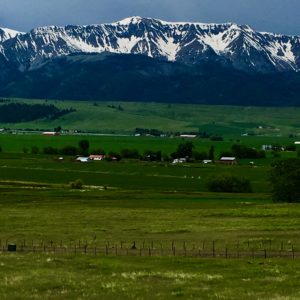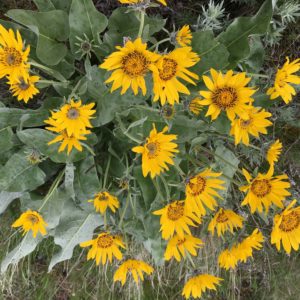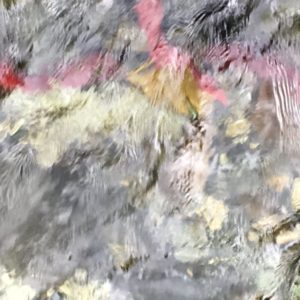The Seasons of Summer
While summer is one season, it occurs to me that there are seasons to summer. Seasons within this one season.
 I am back at the family cabin in the Wallowa Mountains of Northeastern Oregon. It is cool this morning, upper 40’s I’d guess. Cool enough that I built a fire in the fireplace for the first time since early June.
I am back at the family cabin in the Wallowa Mountains of Northeastern Oregon. It is cool this morning, upper 40’s I’d guess. Cool enough that I built a fire in the fireplace for the first time since early June.
That’s a sign — a fire in the fireplace — of late summer, edging toward fall.
Another shift of late summer is the angle of the sun, which is far enough on its journey south that it no longer sets over the saddle on Joseph Mountain due west of us. And the light is different, less direct.
The ground squirrels, a.k.a. Red Diggers, have already gone to ground, disppeared for another year. The Golden Mantle squirrels are gathering as many nuts and seeds as they can stuff into their cheeks.
It’s not unusual to get the first snow in the mountains now, in late summer. At the cabin (elevation 4500’) it will be rain. But when you look up (mountain tops at 8000’ to 10,000’), there will be a fresh dusting of white. I remember being snowed out on a late August backpacking trip years ago.
It seems such a short time ago that it was mid, or high, summer, the main feature of which was heat. Temperatures in the 80’s and 90’s were normal. Lower down, in the Wallowa Valley, it bumped toward 100. Every day was a day to get into the Lake.
With the exception of swimming, in mid-summer you planned your activities for early in the day or late. Too hot to do much at mid-day. At least for me. Not everyone has a choice.
It was mid-summer when the animals brought out their young. The does with their fawns. The mother Merganser with her ducklings (as many as 14). Mom and Dad Quail with their flock, again 12 to 14, the chicks so small at first that they look more like big bugs than birds.
I don’t know what male Merganser’s do (leave I guess), but the male Quail sticks around and is on duty. The female leads the chicks as they learn to hunt for food. The male is always perched on some high spot, a rock or log, keeping an eye out, ready to sound the alarm.
By late summer, the young quail are big enough to fly and more or less fend for themselves. The fawns still follow their mothers, but seem to have been weaned. The Robins, Red-Tailed Hawks and Bald Eagles have all fledged from their respective nests.
The hay farmers got their second crop of the season in then, early August. Wallowa County hay is high-grade stuff. Most of it is exported to Japan, for Kobe beef, or to Kentucky and Saudi Arabia for race horses. They will hope for a third crop of alfalfa hay in late September. The timothy hay, which takes longer, is two crops and done.
It would still, even in hot mid-summer, cool down in the evenings. We had fires outside until the Forest Service banned them.
 Early summer — I’m working backward — was so green (see photo above). In early summer the glacial moraines above the Lake are a soft green, spiked with yellow flowers of the Balsa Root (second photo, right) and the purple of Lupine. There was also lots of snow still on the mountains.
Early summer — I’m working backward — was so green (see photo above). In early summer the glacial moraines above the Lake are a soft green, spiked with yellow flowers of the Balsa Root (second photo, right) and the purple of Lupine. There was also lots of snow still on the mountains.
The river was so full that, with the bedroom windows open at night, you heard the river rush and roar. Sometimes you heard the water rolling the rocks in the riverbed.
Now there seems to be one more season of summer, a new one. The smoke and haze season. Over the past decade that has become predictable in August. Never had it until now, unless there was a local fire and then the smoke was short-lived. Now, days of it, all across the Northwest.
I spoke the other evening with a man who runs his own fire-fighting crew, subcontracting with the Forest Service. He was just back from a long season in California.
Some years ago, he had been a sheep rancher, with herds numbering in the thousands. That was in the area that became the Hell’s Canyon National Recreation Area in the 1980’s. After that designation, no more sheep ranching in Hell’s Canyon.
But the sheep, it turns out, were ideally suited for fire prevention in these mountainous areas, where fighting fires is so difficult. The sheep cleared out the low growth that now accumulates and fuels many fires. Not only that, they fertilize the land.
“Would we ever use sheep again as a fire-prevention measure?” I asked. “Probably not, not enough money in it. Right now, there’s so much money in fire-fighting. It’s big business.”
 A final sign of late summer: the spawning of the Kokenee Salmon up the Wallowa River. The orange are the Kokenee. Not a great picture — too much glare off the water — but you get the idea. (Photo taken 8/27/18).
A final sign of late summer: the spawning of the Kokenee Salmon up the Wallowa River. The orange are the Kokenee. Not a great picture — too much glare off the water — but you get the idea. (Photo taken 8/27/18).
![Anthony B. Robinson [logo]](https://www.anthonybrobinson.com/wp-content/themes/anthonybrobinson/images/logo.png)
![Anthony B. Robinson [logo]](https://www.anthonybrobinson.com/wp-content/themes/anthonybrobinson/images/logo-print.png)